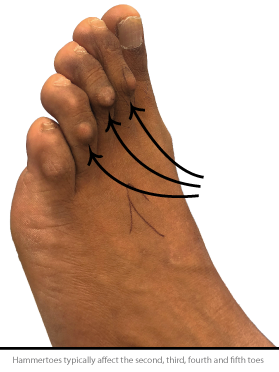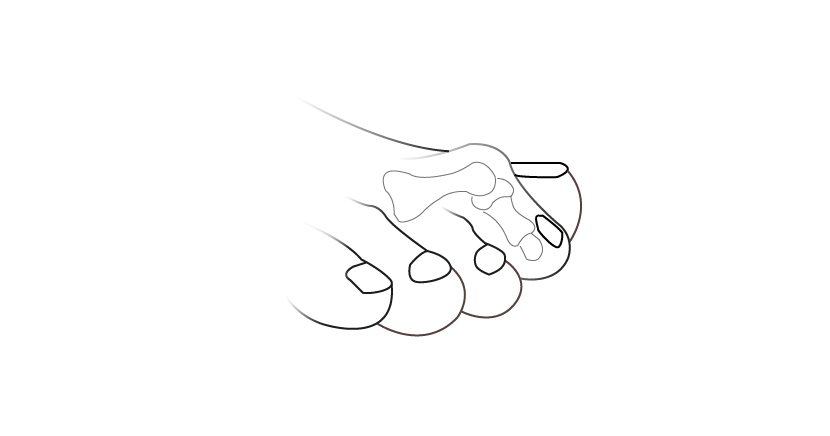Hammer Toe Surgery
What are Hammer Toes and why do they develop?
A toe is described as ‘Hammered’ when it becomes permanently bent at the first joint. This is due to a muscle imbalance; the toe is normally straight due to the equal forces of the surrounding muscles and tendons, but when the muscles become weak the tendons can pull the toe out of shape.
What does a Hammer Toe look like?
A Hammer Toe is quite distinctive when compared to a toe with natural alignment. Though they can be more or less severely bent:

Treatment for Hammer Toe
Hammer Toes can cause a range of problems, including problems fitting into footwear and corns / callus that result from rubbing against footwear, which can cause painful symptoms. The pain and footwear issues can often be treated without surgery , though surgery can be used to correct the underlying issue.
When is Hammer Toe surgery recommended?
If the Hammer Toe symptoms do not resolve with more conservative measures then your specialist may recommend surgery to permanently resolve the issue.
What are the alternatives to Hammer Toe surgery?
Non-surgical treatment of Hammer Toes typically aims to address the symptoms rather than correct the bent toe. These might include:
- Orthotics
- NSAIDS – to manage painful episodes
- Appropriate Footwear – which does not put undue pressure on the toe joints and has sufficient room in the toe box
- Splints or cushioning
Can you straighten Hammer Toes without surgery?
It is possible to reverse the progression of Hammer Toes with conservative measures, such as splints, cushioning and exercises. However, if the toe becomes rigid or fixed in the hammered position, surgery is used to correct the alignment.
Types of Toe Surgery
An incision is made over the top of your toe. A small piece of bone will be removed and then sutured at the joint capsule between the bone ends.
You should rest at home for two weeks following the procedure. You can return to work after two weeks postoperative. At six weeks postoperative you can continue with high impact activities, such as the gym or running.
You should rest at home for two weeks following the procedure. You can return to work after two weeks postoperative. At six weeks postoperative you can continue with high impact activities, such as the gym or running.
An arthrodesis procedure is where the affected joint of the toe is removed and then the bones fused together into a corrected position. This fused joint will no longer move.
An incision is made over the top of your toe. The affected joint is removed and then fused with the use of K-wires. The wires will protrude out the tip of your toe until they are removed at 4-6 weeks post operatively. We also use newer implants that allow an early return to shoes and do not require wires sticking out of the end of the toes in most cases.
You should rest at home for the first three – four weeks following your procedure. You can return to work between three – four weeks postoperatively but need to use a postoperative shoe until the K-wires are removed. At five-six weeks the K-wires will be removed and you will be able to start wearing trainers. At six weeks following your procedure you can return to high impact activities, such as the gym and running.
The main benefit of carrying out toe correction fusion (Arthrodesis) with the use of a Nextradesis or Smart toe implant is the initial recovery. Typically when wires are used you will need to rest at home for a minimum of 4 weeks, with the use of implants you can instead return to work and closed shoes at two weeks following your procedure.
An incision will be made at the top of the toe. The damaged joint is removed and the implant is inserted in its place.
Following the procedure you should rest at home for two weeks. You can then return to work at two weeks postoperative. At six weeks postoperative you can return to high impact activities, such as the gym or running.
Preparing for Hammer Toe surgery
Your foot specialist will advise on a specific toe procedure for your case. You will receive detailed information on the operation prior to the surgery.
There are several things to prepare beforehand. Some important considerations are:
- Let your family and friends know what is happening. This way you will benefit from support such as, checking in on you, helping perform certain tasks that might be hard and keeping you engaged and entertained.
- Prepare your house so that things you will need often are close at hand. This will reduce any need to move frequently. It is often a sensible decision to move your bed to the ground floor.
- Stock up on supplies, such as food and other necessities. This will decrease how often you will need to leave the house.
Hammer Toe surgery before and after
Follow the below link to our gallery to see images of Before and After Bunion Surgery.
What to expect after Hammer Toe surgery
You will normally return home on the same day, following the procedure. You will be given instructions on looking after the surgery site and what to expect while recovering. You will be reviewed at important points in time in the subsequent weeks to make sure everything is as expected.
Hammer Toe surgery recovery tips
One of the most important tips for a fast and problem-free recovery is to follow the PRIE regime:
- Protect – you will be advised on how to protect the area while recovering from surgery
- Rest – you will require considerable rest following surgery to allow the area to heal. There will be a very gradual return to activity
- Ice – Icing the area can help with pain and swelling
- Elevate – this will also help with swelling and pain and promote recovery
Recovery time after Hammer Toe surgery
A good rule of thumb is that you will return to normal activity over a period of approximately 8 weeks, though it may take longer for the swelling to fully subside. Your surgeon will provide more detailed information on what to expect from you recovery.
The Average cost of Hammer Toe surgery in the UK
The price for Toe Surgery can vary, depending on a number of factors, including:
- The number of toes that need correcting
- Whether the procedure is for both feet or just one foot
- Whether toe implants are used
- If you are self funding or using private insurance; insurance providers often set the fees.
Our team will be able to provide a detailed breakdown of fees following your assessment.



